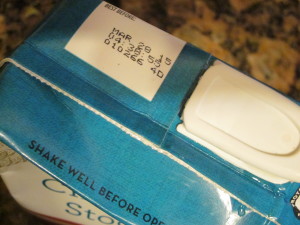 It seems that I am always adding chicken broth to a dish I’m preparing. I am a big fan of slow cooking and have whipped up great jambalayas or different kinds of soups and stews in my Crockpot.
It seems that I am always adding chicken broth to a dish I’m preparing. I am a big fan of slow cooking and have whipped up great jambalayas or different kinds of soups and stews in my Crockpot.
Planning on firing up my old Rival the other day, I checked my cupboard for ingredients.
For what I planned to make, I bought fresh celery, onions and bell peppers from Harvesttime. I also needed allspice and bay leaves, red wine and chicken broth, which I expected to find in my kitchen.
I pulled out a couple boxes of chicken broth from the rotating plastic storage shelf under my counter. I looked at the expiration dates marked in the little white square at the top of each box.
One was marked January 15, 2016. The expiration date on the other box was a date in March, 2015; barely two months ago.
A had a small dilemma.
Should I throw the box with the expired date out? It was not even two months past the date.
I called up the store where I bought the product. Though the clerk didn’t want to give any advice that might lead to legal liability, she reminded me that the dates did not actually reflect a product safety standard but rather was intended to suggest a freshness guideline.
The broth was simply pronounced “best quality” if used before such and such a date.
I decided to open the recently expired box first. I didn’t want to waste anything that might still be good.
I remember my mother sniffing leftovers from the refrigerator when I was growing up; food baked in a rectangular Pyrex dish covered with aluminum foil or a serving of something stored in Tupperware.
We had come to count on the whiff test. We believed that one whiff could determine whether a secondhand meal was still worth eating or whether, as we used to say in our household, it had degraded into a science project.
I poured some broth from the box marked with a March 2015 quality date into a glass measuring cup and took a whiff.
While it didn’t smell and wasn’t cloudy, I decided it was sort of dark, a brownish gold rather than a yellow gold, and I held off pouring the liquid into my Crockpot. What kind of chicken made this color of broth? I wondered.
Then I decided to open the other box of broth and poured some into a different glass measuring cup. It was a much lighter color. I sniffed them both. I studied the variation in color again.
Then I poured the contents of the first box down the drain followed by warm water from the tap.
I decided that using chicken broth from the first box would probably not make me sick but that it was not worth the $1.99 to angst over it. Besides, didn’t I deserve broth with a “best if used by..” label showing a date in the future?
I don’t normally pay much attention to food labels but took a few moments in my kitchen to contemplate them.
Some people rely on labels regularly to note sodium levels or ingredients that they might have allergic reactions to. These kind of warnings are not intrusive but can make life a lot easier.
Following date stamping and other guidelines printed on food items long stored on a pantry shelf, not to mention paying attention to your intuition about what would feel good to consume, is no small thing.


Leave a comment